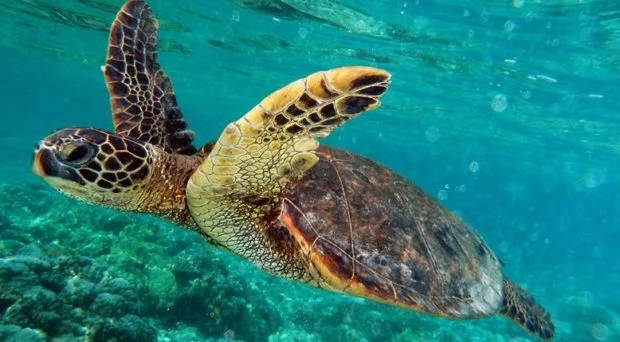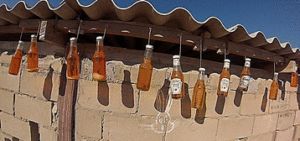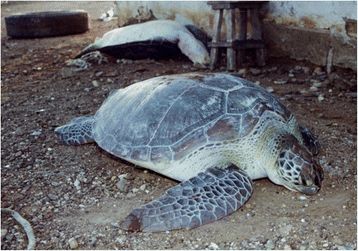论文题目:Trade of marine turtles along the Southwestern Coast of the Gulf of Venezuela
期刊:Marine Biodiversity Records
作者:H. Barrios-Garrido et al.
发表时间:2017/05/23
数字识别码:10.1186/s41200-017-0115-0
原文链接:https://mbr.biomedcentral.com/articles/10.1186/s41200-017-0115-0?utm_source=Other_website&utm_medium=Website_links&utm_content=DaiDen-BMC-Marine_Biodiversity_Records-Biodiversity-China&utm_campaign=AJL_USG_DDX_bmc_article2
保护濒临灭绝的物种往往会影响当地居民的生活。在委内瑞拉海湾,人们消费和交易受保护的海龟,并以此谋生。Marine Biodiversity Records发表的研究深入探讨了这一困境,与当地居民交流了海龟在其文化中扮演的角色,并提出了改善保护工作的建议。

在委内瑞拉湾,绿海龟是受到商业消费影响最大的品种
海龟贸易和消费相关的文化传统意味着保护海龟的相关法律在某些地区被无视。对委内瑞拉湾瓜吉拉半岛为期15年的研究发现,尽管海龟贸易和消费是非法的,却普遍存在。
研究人员发现,该地区至少有四种海龟(绿海龟、玳瑁、红海龟和棱皮龟)被交易,以获取它们的肉类、龟壳和海龟油脂。绿海龟是最常被交易的品种,而最昂贵的产品来自玳瑁龟。
这种交易活动是海龟保护工作所担心的,贸易和消费给当地的海龟种群造成了压力。在委内瑞拉海湾,位列世界自然保护联盟濒危动物名单中的绿海龟是受商业消费影响最大的物种。
传统文化和物种保护
生活在海岸附近的瓦尤人被称为“Apaalanchis”,并将自己形容为海上牧人。他们使用海龟来维持自己的文化。
数千年来海龟在许多文化中有重要作用,兼具功利和神话的目的。目前,以消费目的海龟捕捉主要与热带发展中国家的小规模渔业有关。
其中一个这样的社区是瓜吉拉半岛的原住民瓦尤人。生活在海岸附近的瓦尤人被称为“Apaalanchis”,并将自己形容为海上牧人。他们使用海龟来维持自己的文化。
在2002年至2017年间,研究人员通过访问渔民、批发商、餐馆老板和买家等从事海龟相关行业的瓦尤人收集了定性数据。他们将这些数据与瓜希拉半岛市场和交易中心的观察结果结合起来。
在采访中,瓦尤人描述了他们与海龟有关的传统,并强调了海龟的文化和精神意义:
“海龟是上帝的礼物,但非原住民不明白”
其他人评论说,海龟对他们的生活方式至关重要:
“因为有海龟,我才能养家糊口”
“我为我哥哥准备海龟油,他给我山羊肉”

等待出售或在家庭间交换的瓶装玳瑁油
虽然海龟的消费和使用对于瓦尤人来说确实很重要,但在委内瑞拉,根据国家政府立法和总统法令,这是非法的,就像在大多数加勒比国家一样。委内瑞拉也是许多海龟保护国际条约的签署国之一。
瓦尤人并不是不知道相关法律,但他们认为海龟的使用是正确且符合传统的。作者发现几乎没有相关监管或强制措施阻止瓦尤人使用和交易海龟。
由于该地区经济萧条,越来越多的产品被商业化:
“我们知道这被认为是非法的,但我们需要使用海龟来购买商品”。

市场上(LosFilúos)等待最终买家的绿海龟。
一些接受采访的瓦尤人表示,他们将产品卖到哥伦比亚边境外,以获得更高的价格:
“哥伦比亚的外地人对海龟产品出价很高”
此外,与野生动物保护法相矛盾的法律阻碍了其效力。例如,法律规定委内瑞拉的原住民有权使用该地区的自然资源。其中委内瑞拉签署的国际条约“原住民和部落人民公约”便规定保护自然资源的传统用途。
海龟的保护
作者报道的海龟持续使用突出表明收集更多该地区海龟种群数量和稳定性相关数据的需求。之后才可能明确人类使用所造成的真正影响。
作者提出,如果瓦尤人使用海龟受到法律的豁免,那么可能需要排除商业化使用的部分。在澳大利亚有类似规定,原住民和托雷斯海峡岛民根据澳大利亚原住民土地权法有维持传统文化、非商业性使用海龟的合法权利。
在委内瑞拉,当地非政府组织“Grupo de Trabajo en Tortugas Marinas del Golfo de Venezuela(GTTM-GV)”目前正在实施双语保护行动,在当地利益相关者的支持下解决在该地区使用海龟的问题。
有效保护这些脆弱和濒危的动物需要有关单位的支持,从而制定有效的管理计划,区分海龟的传统和非法使用,并遵循文化和生态兼顾的方式进行管理。
摘要:
Background
Marine turtles play an important role in the culture and economy of numerous coastal communities around the world. However, the legal framework that regulates the consumptive use of these reptiles varies among countries.For example, the consumption of these reptiles has been regarded as common in several rural areas of Venezuela, especially in the eastern coast of the Guajira Peninsula.
Methods
To assess the scale and cultural component of this use, we interviewed 35 residents from the southwestern coast of the Gulf of Venezuela (Venezuelan part of the Guajira Peninsula), using a combination of in-depth and semi-structured interviews. We carried out a field and detailed market-based observations on the Guajira Peninsula to detect the sale and use of marine turtle products. We focused on three main categories of use; the type of product, routes of trade, and the price of products.
Results
All of the marine turtle species reported from the Gulf of Venezuela were used, and the prices of products varied among their type, species of origin, and the distance from the capture area to a marketplace. We obtained evidence connecting Wayuú Indigenous peoples traditions and beliefs with marine turtle use, and also they are used as traditional products such as medicine, and as an economic resource to sustain their communities.
Conclusion
It is probable that trade of marine turtle products is placing pressure on populations in the Gulf of Venezuela. We recommend the implementation of an inter-institutional conservation-portfolio be developed for the Peninsula to evaluate actions related to this concern.
阅读论文原文,请访问:https://mbr.biomedcentral.com/articles/10.1186/s41200-017-0115-0?utm_source=Other_website&utm_medium=Website_links&utm_content=DaiDen-BMC-Marine_Biodiversity_Records-Biodiversity-China&utm_campaign=AJL_USG_DDX_bmc_article2
期刊介绍:Marine Biodiversity Records is a rapid peer-reviewed, online, open access publication that complements the long-established Journal of the Marine Biological Association of the United Kingdom. Marine Biodiversity Records has been launched in response to the changing marine and coastal environment and an increasing demand for the documentation of marine organisms in locations where they have not formerly been recorded, as well as of species loss from habitats.
2016 Journal Metrics
Citation Impact
0.267 - Source Normalized Impact per Paper (SNIP)
0.213 - SCImago Journal Rank (SJR)
(来源:科学网)
特别声明:本文转载仅仅是出于传播信息的需要,并不意味着代表本网站观点或证实其内容的真实性;如其他媒体、网站或个人从本网站转载使用,须保留本网站注明的“来源”,并自负版权等法律责任;作者如果不希望被转载或者联系转载稿费等事宜,请与我们接洽。